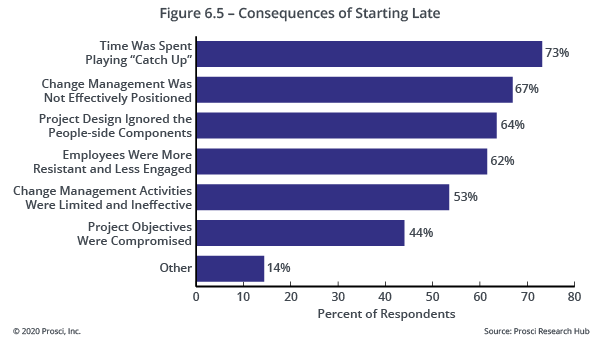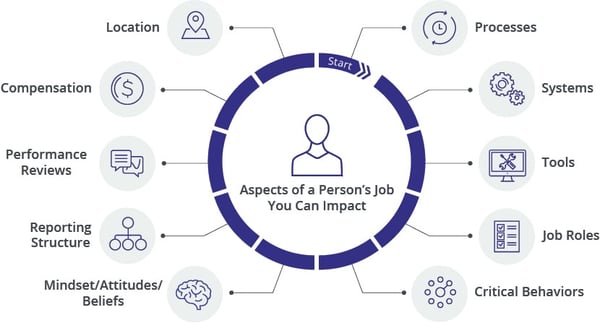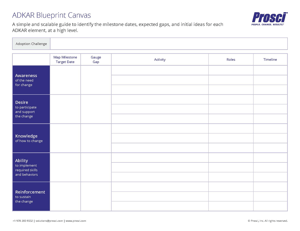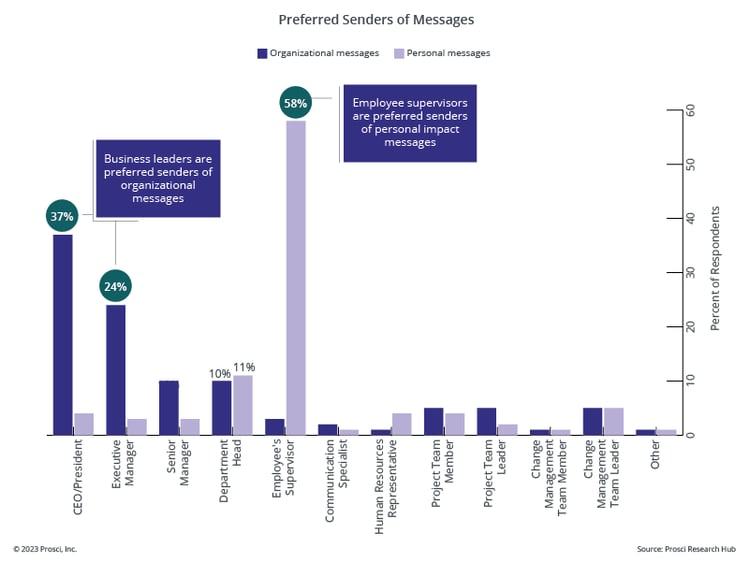What to Do When Change Management Starts Late

5 Mins
Updated: August 5, 2024
Published: June 22, 2022

Some organizations only pay attention to the people side of a change when challenges emerge late in the project lifecyle, such as significant resistance and low user adoption. But a reactive approach usually results in a “rescue” mindset with unrealistic expectations. Of course, a change practitioner can’t save a project on their own. However, under the right circumstances, the change practitioner can support and equip individuals in core roles to take actions that mitigate the challenges and enable their organizations to salvage the return on investment (ROI).
Data on When to Start Change Management
Starting change management early in the lifecycle of a change project is always the best approach. Participants in our Best Practices in Change Management research agree—97% said they would start earlier on the next project, during the planning or initiation phases of the project management lifecycle.

How to Adjust Change Management Activities When Starting Late
The unfortunate truth is that organizations that apply change management late don’t appreciate its value. When they run into problems like resistance from impacted groups, and low adoption and usage, they engage a change practitioner hoping they will rescue the project for them.
If your senior leaders have this mindset, you will need to educate them and project leaders on the realities and limitations of using a reactive approach for managing change. You may also need to help them determine if the solution itself is not performing as intended. If this is the case, the only way to be successful is to revise the proposed solution or implement a new one.
If you are starting to apply change management late, following these steps can help you support your organization to achieve the best outcomes given the challenges you’re facing.
1. Assess change management risks and issues
Coming into a project late means you won’t know much about what has happened to date. Significant damage may already have been done. There may be little or no active and visible sponsorship of the change. Impacted groups may be pushing back and resisting the change. If the change hasn’t been communicated effectively, people will lack Awareness of why the change is needed. They also won’t know the benefits of the change for the organization or what’s in it for them.
Completing a risk assessment in collaboration with key stakeholders, such as senior leaders and people managers of the impacted groups, will enable you to define the size and scope of the change, determine the degree to which the organization is change-ready or change-resistant, and gather information on how much damage control is needed.
You also need to identify the groups impacted by the change and the degree of impact they will experience. If your change impacts many groups, you may not have the time to meet the change management needs of every group. You will have to prioritize supporting the impacted groups that are most critical to or represent the greatest risk to the success of the change.
Once you have the results of the risk and impact assessments, you can customize and scale your change management approach based on your current reality.
Prosci's 10 Aspects of Change Impact

2. Activate sponsors and people managers
Change practitioners address the people side of change by working with and through others. Begin by confirming who is the primary sponsor of the change (i.e., the individual who authorized the change and is accountable for ensuring the realization of desired outcomes of the change for the organization). Be sure to review your risk assessment with your primary sponsor and gain their support for the change management approach you believe is required to ensure successful outcomes.
Next, in conjunction with your primary sponsor, identify the individuals who need to sponsor the change with each impacted group. Together with the primary sponsor, this group will comprise the sponsor coalition. Your goal is to support the primary sponsor to build a strong sponsor coalition because this is a key determinant of whether the change will be successful. It’s also important to move quickly to begin building positive working relationships with the sponsor coalition members and influence them to take actions in support of the change.
Note that if you don’t activate your sponsors, they won’t understand or appreciate the importance of their role and will likely place the responsibility for addressing the people side of the change on you, the practitioner. You should not accept that responsibility. Sponsors have the authority over the impacted groups that need to adopt and use the change—and you do not. Your responsibility is to advise sponsors of the actions they should take to be active and visible, build the coalition of support, and communicate effectively. But the sponsors need to commit to performing the recommended actions themselves.
It is also your job to support the sponsors to activate the people managers of the groups impacted by the change. Do the people managers support the change themselves, and understand and accept their roles in leading the change in their respective parts of the organization? If they don’t support the change or lack understanding of the critical role they play, the change is likely to fail. It is critical that you prepare people managers to fulfill their role in leading their teams through the change.
3. Use the ADKAR Blueprint to address the largest change management gaps
 The customized and scaled approach you recommend should reflect the reality that you will not likely have time to build core and extend change management plans. The ADKAR Blueprint is a better option—it requires you to identify the ADKAR elements with the largest gaps and recommend the actions that address those gaps. When developing your ADKAR Blueprint, focus first on the actions required to support the impacted groups that you have determined are most critical to or represent the greatest risk to the success of the change.
The customized and scaled approach you recommend should reflect the reality that you will not likely have time to build core and extend change management plans. The ADKAR Blueprint is a better option—it requires you to identify the ADKAR elements with the largest gaps and recommend the actions that address those gaps. When developing your ADKAR Blueprint, focus first on the actions required to support the impacted groups that you have determined are most critical to or represent the greatest risk to the success of the change.
Some gaps you identify will be a result of not starting change management at project initiation. For example, you may be in a catch-up scenario where the project team is ready to implement the change, but they are encountering resistance from members of impacted groups who have a large gap at Awareness (i.e., they don’t understand why the change is needed). If this is your reality, you need to move quickly to determine the communication activities that will close the Awareness gap and enable people to progress through their individual transitions.
A significant risk for the change practitioner in the catch-up scenario is that the sponsors and people managers will not only expect you identify the communication activities required, but may also expect you to be the communicator of key messages about the change. Your responsibility is to identify the communication activities and draft the communications.
Delivering the communications is the responsibility of the sponsors and people managers. They need to take an active and visible role in leading the change, starting with communicating the need for the change. This will require you to educate the primary sponsor, sponsor coalition members, project manager, and people managers on the key messages that need to be communicated. You’ll also need to educate them on when and how the messages need to be communicated, and most importantly, by whom (i.e., the preferred senders).

Common tactics reported by our research participants for increasing communications include more frequent town halls, increased status calls, more frequent project updates, more time scheduled for open discussions, and Q&A sessions. Post-communication surveys can also be used to ensure that the key messages being communicated are understood.
4. Integrate and align change management and project management activities
to enable adoption and usage of the change
As you build your ADKAR Blueprint, you should collaborate with the project manager to gain support for the proposed activities and integrating them with the remaining activities of the project team. To achieve an integrated approach, it may be necessary to recommend extending the project timeline or reducing the project scope to ensure that the people side of the change is effectively addressed. If willingness to adjust the project timeline or scope doesn’t exist, you will have to play catch up by shortening or condensing the change management activities.
Tactics to shorten or condense the change management effort include scaling back on the number of activities, eliminating activities, or moving activities that would normally be completed earlier in the project lifecycle to post-implementation. You will need to ensure that your primary sponsor is aware of and willing to accept responsibility for the additional risks and potential negative consequences to the desired outcomes of the change.
Change Management Can Be
Better Late Than Never
Change management activities should begin during the project initiation phase. Unfortunately, that’s not always what happens in the real world. Some organizations only pay attention to change management when issues like significant resistance and low user adoption emerge, often when the project is well underway. Prosci research shows that change management, even if started late, can have a positive impact on achieving desired outcomes from a change. In these cases, some change management can be better than none at all.


